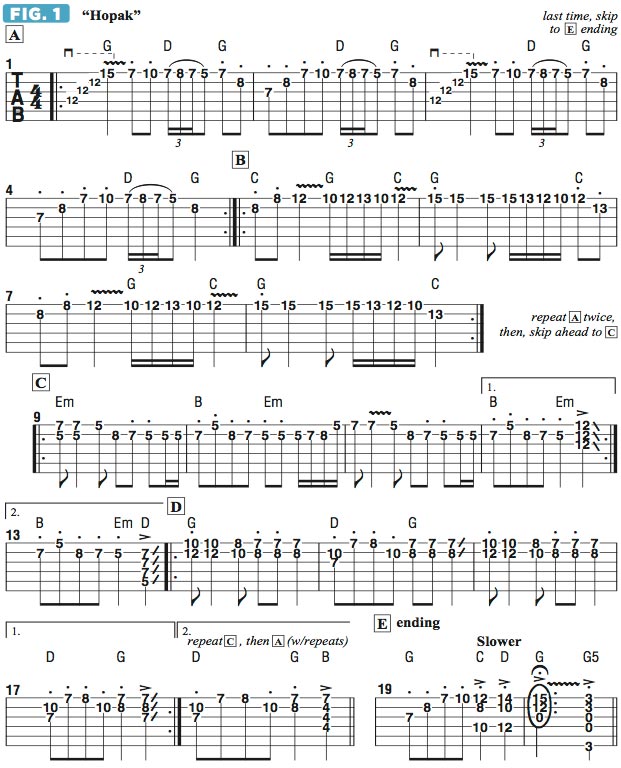“Hopak,” the Uptempo “Fight Club” Song of the Ukrainian Kozaky

In the same lighthearted spirit as last month’s presentation of “The Irish Washerwoman,” I now offer a fun solo guitar arrangement of another enduringly popular, although less well-known, folk-dance tune, this one originating in the opposite side of Europe, Ukraine.
It’s called “Hopak” (See FIGURE 1), which is also the name of a breathtakingly acrobatic “martial-arts-ballet”–style dance traditionally performed by troupes of highly athletic and flexible young men who call themselves cossacks or, in Ukrainian, kozaky (“kaw–za-keh”), dressed in colorful, baggy pants, embroidered shirts and leather riding boots, in celebration of a comrade’s wedding or battle victory against foreign invaders and fueled by adrenaline and vodka.
The concept is to begin slowly and boldly—the “slow clap”—and gradually ramp up the tempo to “cruising speed” by the 16th bar or so, which is then maintained for the remainder of the performance, until the final three chords are played…or until the dancers eventually tire. The challenge is to keep up with the breathtaking pace for the duration of the tune.
The melody begins with an accented grace-note arpeggio sweep into a high G note, fretted with the pinkie. Barre the first three notes with your index finger, then immediately loosen the barre as you strike the high G, to mute the grace notes. Add a robust, shimmering finger vibrato to the G note the first couple of times you play through the tune’s “A” section (bars 1–4).
When you revisit this section later, at the quicker tempo, you won’t have time to add the vibrato and will simply want to nail the G note cleanly, which is chanllenging, as there are big position shifts immediately before and after the note. You’ll notice that there are several additional shifts throughout the arrangement.
These are all made for the sake of staying on the top two strings as much as possible, to achieve a consistently bright timbre. To achieve a uniform attack, pick all the quarter notes and eighth notes with downstrokes, switching to alternate (down-up) picking only for the brief bursts of 16th notes. For a smoother, less intense articulation, you could optionally hammer-on and pull-off some of the 16th notes in bars 5, 6, 7, 8 and 10. When performing the hammer-ons and pull-offs in bars 1–4, hammer firmly and, when pulling-off, pulling the string in toward your palm as you release it.
Many of the eighth notes are to be performed staccato (short and crisp), as indicated by the dots over the tab numbers. This is accomplished by relaxing the fretting finger immediately after picking the note. A fun thing to do here is have a bass player accompany you with a polka- or bluegrass-style root-fifth bass line, following the indicated chord changes. Invite other people to add a hand clap or tambourine hit on every beat and shout a hearty “hey!” on each accented chord in sections “C” and “D,” and you’re guaranteed to liven up any party! Na zdorovja!
All the latest guitar news, interviews, lessons, reviews, deals and more, direct to your inbox!
String Theory May 2016 FIGURE 1

Over the past 30 years, Jimmy Brown has built a reputation as one of the world's finest music educators, through his work as a transcriber and Senior Music Editor for Guitar World magazine and Lessons Editor for its sister publication, Guitar Player. In addition to these roles, Jimmy is also a busy working musician, performing regularly in the greater New York City area. Jimmy earned a Bachelor of Music degree in Jazz Studies and Performance and Music Management from William Paterson University in 1989. He is also an experienced private guitar teacher and an accomplished writer.

